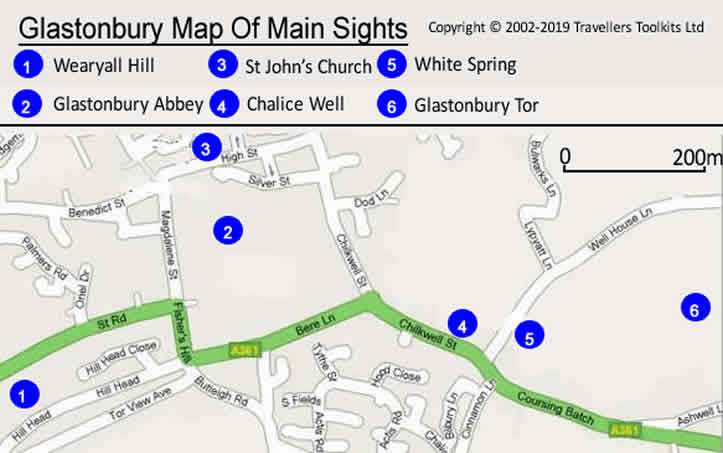Things To Do in Glastonbury Tor
Where is Glastonbury Tor and how to get there?
Tor is the Celtic name for a cone-shaped hill. So Glastonbury Tor is a hill in Glastonbury. People regard the hill as one of the icons of Glastonbury, and they can see it from afar. Most people visiting Glastonbury will find the time and effort to trudge up the hill.
Glastonbury Tor is just to the East of the town of Glastonbury. A 10-minute walk from the High Street and Abbey (well signposted) will take you past Chalice Well to the foot of the Tor. It is then a slog up a paved pathway up the south side of the Tor to the top.
A bus service operates regularly between the main car park near Glastonbury Abbey and Glastonbury Tor. It stops on the north side, making the ascent a bit easier, although the footpath isn’t particularly well-maintained.
On this page we offer a map of the main sights of Glastonbury, including the White Spring, Wearyall Hill, Chalice well, Glastonbury Abbey and the Tor.
Glastonbury Tor history
Somerset Levels – the Tor as an island
In ancient times, the Somerset levels were a shallow, marshy sea. Then, Glastonbury Tor was an island. Neolithic people in the region built platform villages linked by wooden causeways, arguably the first man-made roads.
At some point, no one knows exactly when, the Tor became a sacred site. Viewed close up, one can see its slopes subtly terraced, and some scholars speculate that it forms a remnant of a Neolithic labyrinth.
The Isle of Glass
The Celts called it Ynys Witrin, or the Isle of Glass, and believed it was a gateway to the underworld. Later legend has it that the Tor is the Island of Avalon, burial site of King Arthur.
Saint Michael’s chapel
The tower on the Tor is all that remains of a fourteenth-century chapel dedicated to Saint Michael, a replacement for an earlier church destroyed by an earthquake in 1275.
The chapel is in itself evidence of the site’s pre-Christian roots. It was a common practice to build churches on pagan worship sites both to cement the ascendancy of the new faith and to give the people a Christian gathering place at a familiar spot.
People often dedicated such churches to Michael in his role as spiritual guardian.
Arthurian legends
In the 1960s excavations suggested that a sixth-century fortress or at least a stronghold stood on the site of the Tor, which for some supports another legend connected with the Tor, that it was the location of the stronghold belonging to ‘Melwas’, who is credited in one of the many Arthurian legends as the man who abducted ‘Guinevere’.
There have over the centuries been offered many theories that the hill itself is/was hollow and that this in turn has led to the legends that it was the entrance to the underworld or the place of the ‘Sleeping Lord’.
Ley lines at Glastonbury Tor
Dowsing methods have now traced many ley (power) lines in the earth that for centuries were known to folklore. These are natural geomagnetic lines in the earth.
One such ley line called ‘The Michael line’ is called that because most of the churches on it are dedicated to St Michael, protector of the faith.
‘The Michael line’ flows down from the Tor and then passes through the other major Glastonbury sites – Chalice Well, Glastonbury Abbey and Wearyall Hill – spooky eh?

King Arthur’s Realm day tour from London
Visiting Stonehenge, Glastonbury and Avebury
If you are a visitor from London and would like a really special day out to remember, there is one specialist guided small group tour, King Arthur’s Realm.
This tour will take you into the hidden world of Avalon, a full day out covering many historical and spiritual sites, including Glastonbury as well as two other essential places of pilgrimage; Stonehenge and Avebury.
Out on Salisbury Plain you’ll see the enigmatic World Heritage Site of Stonehenge. Here you’ll witness up close the splendour of the magical stones, and discuss the possible theories behind Stonehenge’s existence.
In Glastonbury you’ll enjoy breathtaking views from the top of the famous Glastonbury Tor and discover secrets at the sacred Chalice Well (where the cup from the Last Supper was said to have been hidden in the First Century by Joseph Arimathea).
At Glastonbury Abbey you can and pay your respects to the grave of Arthur himself.
Finally, at Avebury you can walk the largest prehistoric stone circle in the world. Avebury is a magical place, with lots of ancient history with strong spiritual meaning for many people.
Expect a full day of druids, battles, magic and grail legends with your knowledgeable guide. Not to be missed.